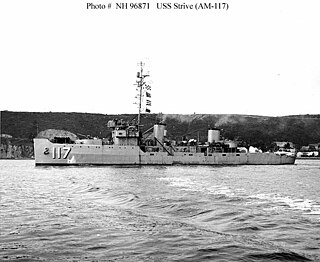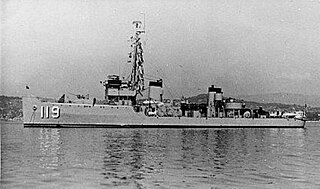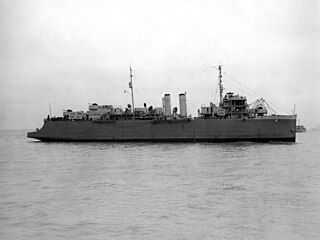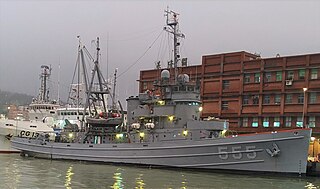
USS Wrangell (AE-12) was laid down under a Maritime Commission contract as SS Midnight during February 1944 at Wilmington, North Carolina, by the North Carolina Shipbuilding Company; launched on 14 April 1944; sponsored by Mrs. G. T. Cambell; delivered to the Navy, incomplete, on 28 May 1944; moved to Hampton Roads; converted to an ammunition ship by the Norfolk Shipbuilding and Drydock Co.; and commissioned on 10 October 1944 at the Norfolk Navy Yard.

USS Jeffers (DD-621/DMS-27), a Gleaves-class destroyer, was the only ship of the United States Navy to be named for Commodore William N. Jeffers.
USS Arikara (AT-98) was an Abnaki-class of fleet ocean tug. It was named after the Arikara, a loose confederacy of sub-tribes of American Indians related to the Pawnee. The Arikara inhabited villages in the Missouri River valley.
USS Symbol (AM-123) was an Auk-class minesweeper acquired by the United States Navy for the dangerous task of removing mines from minefields laid in the water to prevent ships from passing.

USS Strive (AM-117) was an Auk-class minesweeper acquired by the United States Navy for the dangerous task of removing mines from minefields laid in the water to prevent ships from passing.

USS Sustain (AM-119) was an Auk-class minesweeper acquired by the United States Navy for the dangerous task of removing mines from minefields laid in the water to prevent ships from passing.

USS Weehawken (CM-12) was originally SS Estrada Palma – a car ferry built in 1920 by William Cramp & Sons of Philadelphia. It was acquired by the United States Navy on 15 June 1942; renamed Weehawken on 18 July 1942; converted to a minelayer by the Bethlehem Steel Co. at Hoboken, New Jersey; designated CM-12; and commissioned on 30 September 1942.

USS Lipan (AT-85) was a Navajo-class fleet tug constructed for the United States Navy during World War II. Her purpose was to aid ships, usually by towing, on the high seas or in combat or post-combat areas, plus "other duties as assigned." She served in the Pacific Ocean during World War II and the Korean War. She was awarded two battle stars for World War II and four battle stars for the Korean War.

USS Moreno (AT-87) was a Navajo-class fleet tug constructed for the United States Navy during World War II. Her purpose was to aid ships, usually by towing, on the high seas or in combat or post-combat areas, plus "other duties as assigned." She served in the Atlantic Ocean and, at war's end, returned home with three battle stars to her credit.

USS Narragansett (AT-88) was a Navajo-class fleet tug constructed for the United States Navy during World War II. Her purpose was to aid ships, usually by towing, on the high seas or in combat or post-combat areas, plus "other duties as assigned." She served in the Atlantic Ocean and, at war’s end, returned home with three battle stars to her credit.

USS Grapple (ARS-7) is a Diver-class rescue and salvage ship commissioned in the United States Navy from 1943 to 1946 and from 1951 to 1977. In 1977, she was sold to Taiwan and was renamed ROCS Da Hu (ARS-552).
USS Anchor (ARS-13) was an Anchor-class rescue and salvage ship commissioned by the U.S. Navy during World War II. Her task was to come to the aid of stricken vessels.

USS Current (ARS-22) was a Diver-class rescue and salvage ship commissioned by the U.S. Navy during World War II. Her task was to come to the aid of stricken vessels.
USS Deliver (ARS-23) was a Diver-class rescue and salvage ship commissioned by the U.S. Navy during World War II. Her task was to come to the aid of stricken vessels.
USS Valve (ARS-28) was a Diver-class rescue and salvage ship commissioned by the U.S. Navy during World War II. Her task was to come to the aid of stricken vessels.
USS Vent (ARS-29) was a Diver-class rescue and salvage ship commissioned by the U.S. Navy during World War II. Her task was to come to the aid of stricken vessels.

USS Weight (ARS-35) was a Weight-class rescue and salvage ship acquired by the U.S. Navy during World War II. Her task was to come to the aid of stricken vessels. This narrative provides a detailed account of such a task conducted under battle conditions.

USS Baretta (AN-41/YN-60) was an Ailanthus-class net laying ship which served with the U.S. Navy in the western Pacific Ocean theatre of operations during World War II. After surviving war action and Pacific Ocean typhoons, and she returned home safely after the war with one battle star to her credit.

USS Arcturus (AK-18/AKA-1) was an Arcturus-class attack cargo ship named after Arcturus, a star in the constellation Boötes. She served as a commissioned ship for 5 years and 5 months.

USS Jicarilla (ATF-104) was Abnaki-class tugboat during the World War II. The ship was later sold to Colombia as ARC Sebastián De Belalcázar (RM-73). Her namesake is a group of the Apache tribe found in the southwestern United States.













